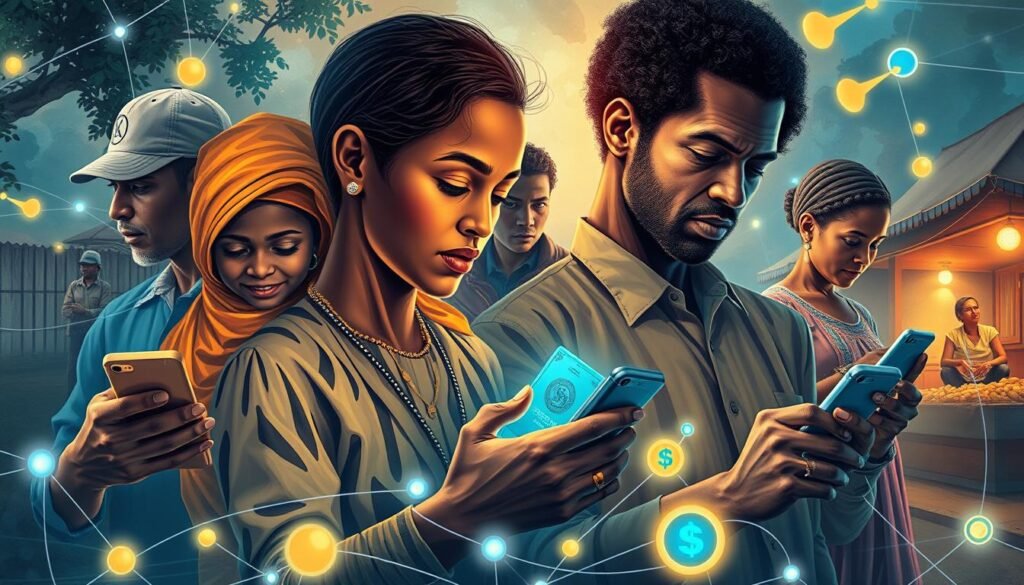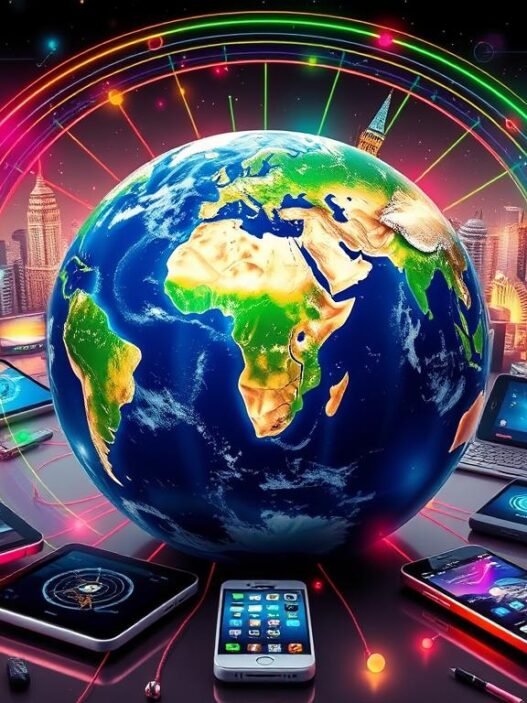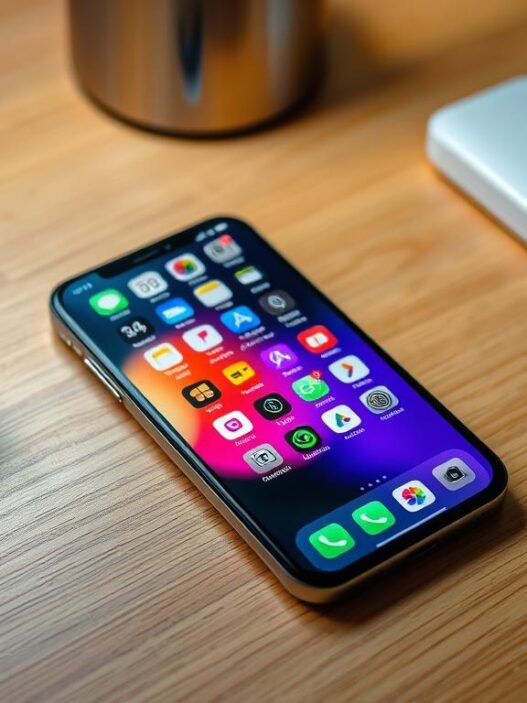Did you know the average person spends 3-4 hours daily on smart devices? That’s like giving one whole day each week to our mobile screens. Mobile technology, introduced by Motorola in 1978, kicked off the communication revolution. It has wrapped the world in a digital connectivity web. Breakthroughs have set mobile devices as vital progress tools. They’re now key in business and entertainment innovation.
Mobile technology’s effect on society is huge. It helps a businessperson close deals across oceans. A grandparent can see their grandchild’s first steps over video call. Mobile connections have changed how we interact, get services, and access info. They’ve even transformed healthcare with wearables.
The rise in mobile use brings challenges. Since 2019, mobile usage has jumped by 50%, showing our increasing reliance. COVID-19 boosted this, increasing remote work, digital learning, and online socializing. This heavy use highlights addiction risks and mental health issues. It also raises privacy and security worries. Yet, these devices amazingly make life easier, helping with everything from finding places to communicating in emergencies.
Key Takeaways
- The profound impact of mobile technology on modern communication and daily life.
- The necessity for mobile connectivity in business operations and social interactions.
- Innovative healthcare solutions enabled by mobile technology.
- The influence of smartphones on entertainment through streaming and gaming.
- Fundamental changes in productivity and work culture due to mobile applications.
- Potential challenges related to mental health, security, and privacy stemming from mobile device usage.
- The undeniable role of mobile technology in driving future digital transformations.
The Dawn of Mobile Technology and Its Evolution
The journey through mobile technology history starts with a historic call in 1973. Dr. Martin Cooper of Motorola made the first mobile phone call on a prototype device. This event marked the start of the Motorola cell phone and the evolution of mobile devices.
Looking into the evolution of mobile phones, it’s evident how they’ve changed. These personal communication devices have gone from simple voice tools to vital parts of our interconnected world. Milestones like the Nordic Mobile Telephone system in 1981, the iPhone in 2007, and 4G LTE and 5G networks changed how we communicate.
The Historical Milestones of Mobile Devices
The history of mobile technology is full of key advancements. We went from bulky analog phones to sleek, digital devices. These devices blend phone and computer features to improve how we use and access mobile technology.
In 1989, the GriDPad introduced touch and stylus interaction. This led to the future development of tablets and smartphones. The shift to the digital age was marked by the move from basic cell phones to smartphones. This was highlighted by Motorola’s Droid in 2009 and the growth of mobile app stores. These stores are crucial in today’s mobile technology.
How Mobile Phones Transformed Global Communication
The transformation of communication in recent years shows the impact of mobile phones on global communication. Initially made for voice calls, they now support SMS, email, and social media. Mobile phones have become essential for personal and professional use.
The advent of 4G LTE and 5G networks significantly improved mobile device capabilities. These improvements support streaming high-definition video and sophisticated enterprise applications. Enhanced connectivity helps personal and business communication worldwide. This makes mobile phones key to the interconnected world.
In conclusion, the journey from the first Motorola handset to the newest 5G devices shows a deep change. The evolution of mobile phones is a story of global connection. It also shows our wish for constant, easy communication.
America’s Dependence on Smartphones
Smartphones are now essential in American lives, not just handy gadgets. The fusion of high-speed networks and constant internet access has changed society at all levels. A stunning 97% of U.S. adults have a smartphone today, up from 81% in 2015, according to Reviews.org. This shows more people are choosing mobile-first lifestyles.
Smartphone Penetration in the US Market
Pew Research Center’s findings highlight the widespread use of smartphones among Americans. These devices have become crucial to our everyday lives. Many folks say they feel anxious without their phone. A striking 74% feel nervous if they can’t locate their device, pointing to a deep bond with their mobile phones.
Impact of Always-On Internet Access
The impact of having non-stop internet through smartphones is huge. It connects us to the world anytime. This access leads to the popularity of apps like Yelp and Uber, changing how we find services and info. Users now expect quick solutions to their needs, thanks to this convenience.
Lifestyle patterns are evolving, too, with more people shopping online via their phones. Pew Research Center says 42% of Americans now buy online mostly using their phones. This was only 11% in 2015. Also, more Americans are using their phones in private spaces, like bathrooms, showing a 75% increase.
The evidence is undeniable. The blend of fast networks, instant access to services, and widespread usage has made smartphones a pillar of American culture. This has shifted how we view and use connectivity.
Wearables: Merging Fashion with Functionality
Today, wearables technology is a big part of our lives. It blends fashion with practicality. This blend is driven by top brands like Apple Watch and Samsung Gear. They provide both style and useful features, making gadgets look good and work well.
Smart clothing is a standout in wearable tech. It uses special materials to make clothes that are smart. These clothes can track health and the environment, giving users instant data. They are used in many areas, including healthcare, the military, and sports, showing how tech fits into various lifestyles.
| Application | Technology Used | Key Benefits |
|---|---|---|
| Healthcare Monitoring | Nano-particles, Metal Fibers | Tracks vitals, physical activities |
| Military & Defense | Conductive Ink | Detects hazardous gases, blood loss |
| Sportswear | Chromic Materials | Enhances wearer comfort |
Smart clothing faces some issues, like high costs and durability concerns. Meanwhile, smartwatches and fitness trackers from Apple, Samsung, and Garmin have become popular. They offer many features, including health monitoring like heart rate and blood-oxygen levels.
Also, with new extended reality devices and hearables, wearables are evolving. Google’s AR glasses and Apple’s AirPods Pro are examples. They’re changing how we use technology, impacting our health, work, and fun.
After the pandemic, there’s a rush towards health-based wearable tech. The combination of cool design and advanced tech not only leads to a healthier life. It also appeals to those who love style, making tech an essential part of our daily life.
Pioneering Futures with Mobile Technology
The addition of voice-command technology and AI into mobile phones makes daily life easier. It starts a new time of interactive digital help. Phones like the Samsung Galaxy Z Fold series and the iPhone 15 lead this change. They show what mobile devices can do.
Smartphones as Personal Assistants
AI helpers like Siri and Ok Google change how we use phones. They listen to our voice commands. This means we can send messages, set reminders, and control our homes simply by talking.
Voice Command and AI Integration in Daily Life
AI integration in phones greatly improves how useful they are. This makes technology easier to use and lessens the mental effort for us. It means we can interact with our phones more smoothly.
The quick progress in the mobile field is shown by Samsung’s new camera technology and faster wireless charging. These advances, like Apple’s latest features, show rapid growth in smartphone technologies. They aim to make devices more responsive and easier to use.
| Feature | Samsung Galaxy Z Fold 5 | Apple iPhone 15 |
|---|---|---|
| Under Display Camera | 4MP, f/1.8, 80-degree FOV | N/A |
| Wireless Charging | 15W Fast Wireless Charging 2.0 | 15W Wireless Charging |
Also, the mobile industry aims to be net-zero by 2050. This, along with the growing choice for refurbished phones, shows a move towards sustainability.
Phones play a big role in education too. More kids using mobile devices means technology is making learning easier and more effective. This helps prepare a smarter, more connected future generation.
Mobile Technology Empowering Developing Economies
In developing areas, mobile tech is making big changes, especially in education and healthcare. It helps connect communities that were left out before. Now, these advancements are boosting economy growth and improving social life.
Educational Opportunities Through Mobile Apps
Mobile education through apps is changing how people learn in developing places. They offer important literacy improvement tools. In places with few schools, these online platforms let students learn a lot. They help users overcome distance and economic hurdles, improving education and making them more independent.
In Ghana, learning apps are sometimes the main way students learn. They help match the education quality between cities and rural areas. Thanks to these apps, students in remote places can learn as much as those in cities. They get to access tons of educational material, making learning fair for all.
Mobile Health: Bridging the Healthcare Gap
Telemedicine and mobile healthcare apps are a big leap for better health in hard-to-reach places. In Ghana, e-pharmacies and drone deliveries are two cool examples. They make sure that everyone can get the health supplies and information they need, improving overall health.
Mobile tech also makes healthcare management smoother. It helps with setting up appointments and sending out reminders for things like shots. Now, doctors can talk to patients far away, making healthcare affordable and accessible. This cuts down travel and wait times, saving money.
This tech is not just solving current problems in these countries. It also shows how digital tools can make the world a fairer place. It’s paving the way for a brighter, more equal future for everyone.
Fostering Financial Inclusion with Mobile Banking
Mobile banking is changing the game in financial inclusion. It offers crucial services in areas that banks often miss. M-Pesa, for instance, has given millions in Africa the power to do business right from their phones.
In many developing areas, finding a bank can be hard. But mobile platforms like M-Pesa fill this gap. They bring banking services to more people, improving lives in rural and remote places.

Mobile banking lets people without bank access get loans, save money, and manage finances easily. They don’t need to visit a bank. This way, more people start using formal financial services, thanks to the ease and safety mobile banking provides.
Key Highlights from Recent Studies Include:
- M-Pesa and similar solutions have helped over 51 million users with easy transactions and managing money.
- There was a 22% boost in borrowing from banks after major policy changes. This shows how mobile money is making finance more inclusive.
- Signing up for a bank account is now quicker than ever, thanks to mobile banking. This improves the customer experience greatly.
- Mobile banking is bringing more financial products to those previously left out, filling in where traditional banks can’t reach.
- With mobile tech, banks can better judge if someone is a good candidate for a loan, making credit more available.
The data proves how mobile banking is helping economic growth and financial inclusion. These technologies keep improving. They aim to give even more people access to banking services. Mobile banking isn’t just about going cashless. It’s also about fighting poverty and boosting the economy.
The Transformative Power of Mobile Connectivity
Mobile technology is weaving itself into the fabric of our digital world. The global impact of mobile devices is massive, changing how we consume digital media. This change affects both individual habits and industrial practices.
Mobile connectivity is a key player in today’s tech advances. It changes how we see and use the digital world. Visit here to explore more about technological advancements Thanks to fast-growing mobile phone adoption, people engage differently with digital content. This is due to better and faster mobile networks, like 5G.
The Global Impact of Mobile Devices
The shift from 2G to 5G has been huge. 5G networks combine old 4G tech with the new 5G NR. It’s not just about speed. It’s also about stable, fast, and responsive connections. These advances support mobile-driven innovation, sparking the growth of the Internet of Things (IoT).
By 2025, billions of devices will connect, showing the mobile devices global impact.
Creating New Opportunities with Portable Technology
Mobile tech keeps evolving, with developments like LTE-M and NB-IoT. They work with upcoming 5G networks. This supports the Kickstarter generation—innovators who use crowdfunding to bring ideas to life.
Portable technology is opening doors for startups. It lets new mobile tech and apps grow. This growth boosts sectors like agriculture and healthcare. The expansion of advanced mobile networks marks a new wave of entrepreneurship. It’s all part of the mobile-driven innovation.
Mobile tech is now a big part of our lives and economy. It underscores how mobile progress is changing the world. It’s altering how we interact, work, and become more efficient globally.
The Rise of Secondary Mobile Marketplaces
The secondary mobile market is booming. This is mostly because of the increase in mobile device trade-in programs. It’s also because more people want affordable smartphones. This market helps mobile devices last longer. It also makes technology available to more people.
Recent data shows the secondary mobile market is growing fast. In 2023, around 309.4 million used smartphones were shipped worldwide. That’s a 9.5% increase from last year. Meanwhile, sales of new smartphones are expected to drop by 3.5%.
| Year | Used Smartphone Shipments | New Smartphone Shipments Growth | Used Smartphone Revenue ($ million) |
|---|---|---|---|
| 2023 | 309.4 million units | -3.5% | 64,695 |
| 2027 | 431.1 million units | Forecast unprovided | 109,666 |
Developed markets are waiting longer to refresh their devices, now over 40 months. This changes the inventory for the secondary market. The market shrank slightly, by 2.7%. This is due to the longer refresh rates and lower spending.
North America plays a big role in the secondary market. It brought in 26,653 million USD from used smartphones in 2023. This was 41.2% of the world’s earnings from used smartphones. The region’s strong market supports lots of mobile device trade-ins. This lets people get affordable smartphones in a sustainable way.
The price of second-hand devices has dropped to $304 on average. This makes the secondary mobile market more appealing. People are buying more used smartphones. They like the mix of good features and lower cost. The market for used devices grew by 2.9% this year. At the same time, new device sales fell by 4.4%.
The secondary mobile market is set to keep growing. This will happen through better trade-in programs and smart reuse strategies. These improvements will meet higher demand and help the environment.
Mobile Technology as the Keystone of the Digital Era
Mobile technology is a core part of today’s digital world. It reaches across different areas, changing how we live and work. It makes mobile devices key to how people consume digital media. This changes how we engage with content and understand the world.
The widespread use of mobile tech helps collect lots of data. This data is crucial for tackling big world issues. For example, health organizations use this data to predict and manage health crises better. They can send help where it’s most needed. Also, data on what people do with their mobiles helps businesses improve their services for digital users.

The Economic and Social Impacts of Mobile Usage
Mobile technology has greatly affected the economy. It has changed how businesses work, moving them online. Now, they can offer services through apps. This makes things more efficient and helps them reach customers everywhere, no matter where they are.
Mobiles have also changed how we interact with each other and access information. They keep us updated with global news and social happenings. Having educational and health info on mobiles is crucial. It helps grow societies, especially in places that are hard to reach.
Addressing Global Problems Through Mobile Data Collection
Collecting data through mobiles is key to solving big problems. It supports efforts in health, education, and the environment. This data helps monitor pollution, track animals, and manage natural disasters better. With so many people using mobiles, this data is a powerful tool for making the world better.
- Enhanced connectivity allows for quick communication and sharing, especially in emergencies.
- Mobile tech offers many applications, like health apps and online learning. These help provide services, especially in hard-to-reach places.
In this digital age, mobile technology is vital. It shapes our economy and society, making us stronger, more informed, and always connected.
Modern Innovations and the Future of Mobile Technology
Mobile technology is evolving fast, thanks to AI and mobile innovation, smartphone advancements, and a push towards the future. This evolution includes the use of smartphone technology and 5G networks. Such changes are shaping how we use technology both now and in the future.
Smartphones have transformed from simple tools for calling into complex, AI-driven devices. They offer new features like foldable screens, advanced cameras, and 5G connectivity. These changes are redefining our interactions with mobile devices.
| Feature | 2019 | Emerging Trends | 2024 Forecast |
|---|---|---|---|
| Camera Technology | 64-megapixel introduction | AI-enhanced imaging, Night mode | Widespread ultra-high-resolution adoption |
| Foldable Screens | Early Adoption | Technological refinements | Expected market breakthrough |
| 5G Integration | Initial rollouts | Rapid expansion about 5G networks | 1.6 billion subscriptions projected |
| AI Integration | Basic functionalities | Enhanced user interaction and automation | Core technology in smartphones |
AI is greatly improving smartphones, setting the stage for future tech. Soon, phones may act on their own in our personal and work lives.
The growth of 5G technology is a big deal. It offers super-fast speeds and low latency. This improves apps and devices that rely on mobile internet. The surge in 5G use will also help advance IoT, AR, and VR technologies.
With the development of strong, foldable devices and more AI features, the future of mobile technology is exciting. These smartphone advancements are not just steps forward but leaps. They promise a new age of digital experience driven by AI and mobile innovation.
Conclusion
Mobile technology has become a big part of our lives, changing how we work and play. The mobile evolution isn’t just about better phones. It’s about how the world connects more easily than ever. Nowadays, 92.3% of people who use the internet do so through their phones. This shows we’re moving towards a connected future.
Smartphones are everywhere, with more than half of people in many countries owning one. This boom in smartphones has made online shopping more popular. It also shows how technology changes the way we live. Mobile banking makes money matters easier and clearer. Health apps help millions take care of themselves better. These changes show how tech moves us forward. They change how we buy things and work, leading to growth in jobs and the economy.
Education, health, and jobs are all feeling the impact of new tech. More people are using telemedicine, learning online, and working from anywhere with mobile apps. These changes show mobile tech’s power to transform lives. But, we also face challenges. We’re more worried about privacy and battling digital addiction. As tech keeps growing, we must make sure it’s safe for everyone. Looking at mobile tech’s journey, we see progress and challenges. But, the future it brings is full of promise and responsibility towards a connected future.















